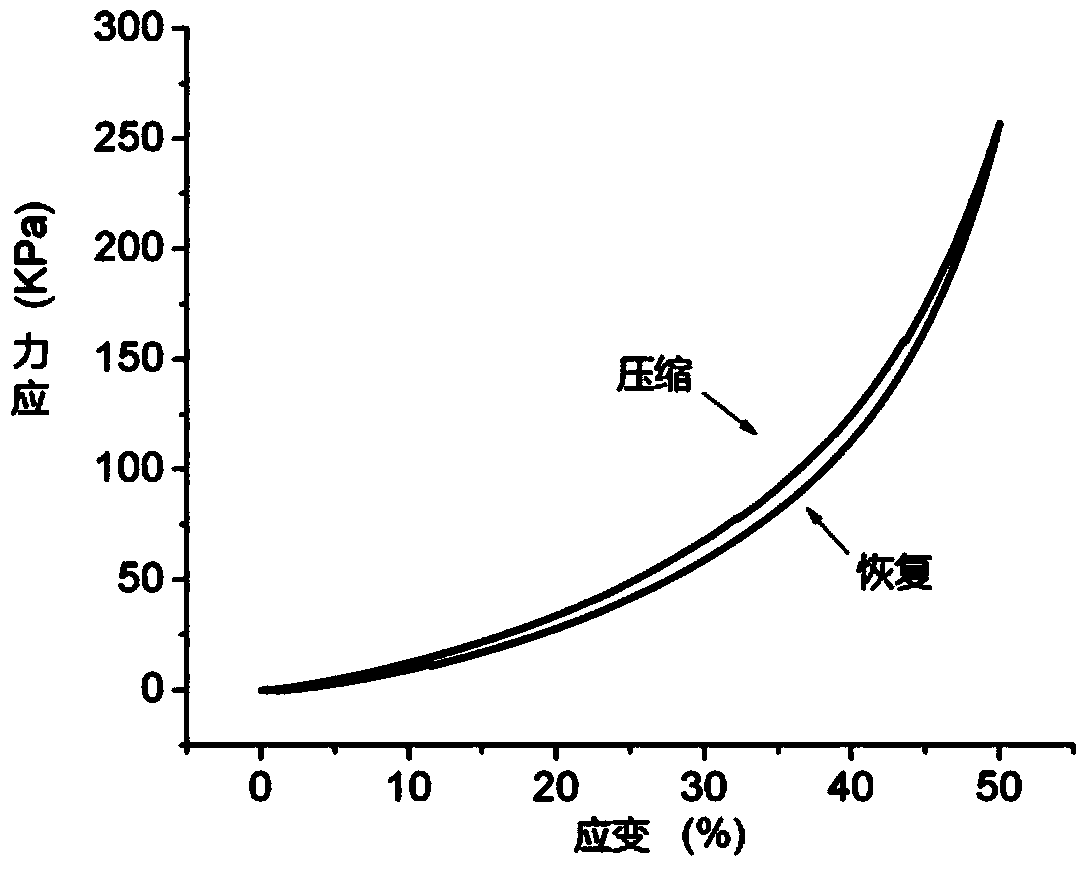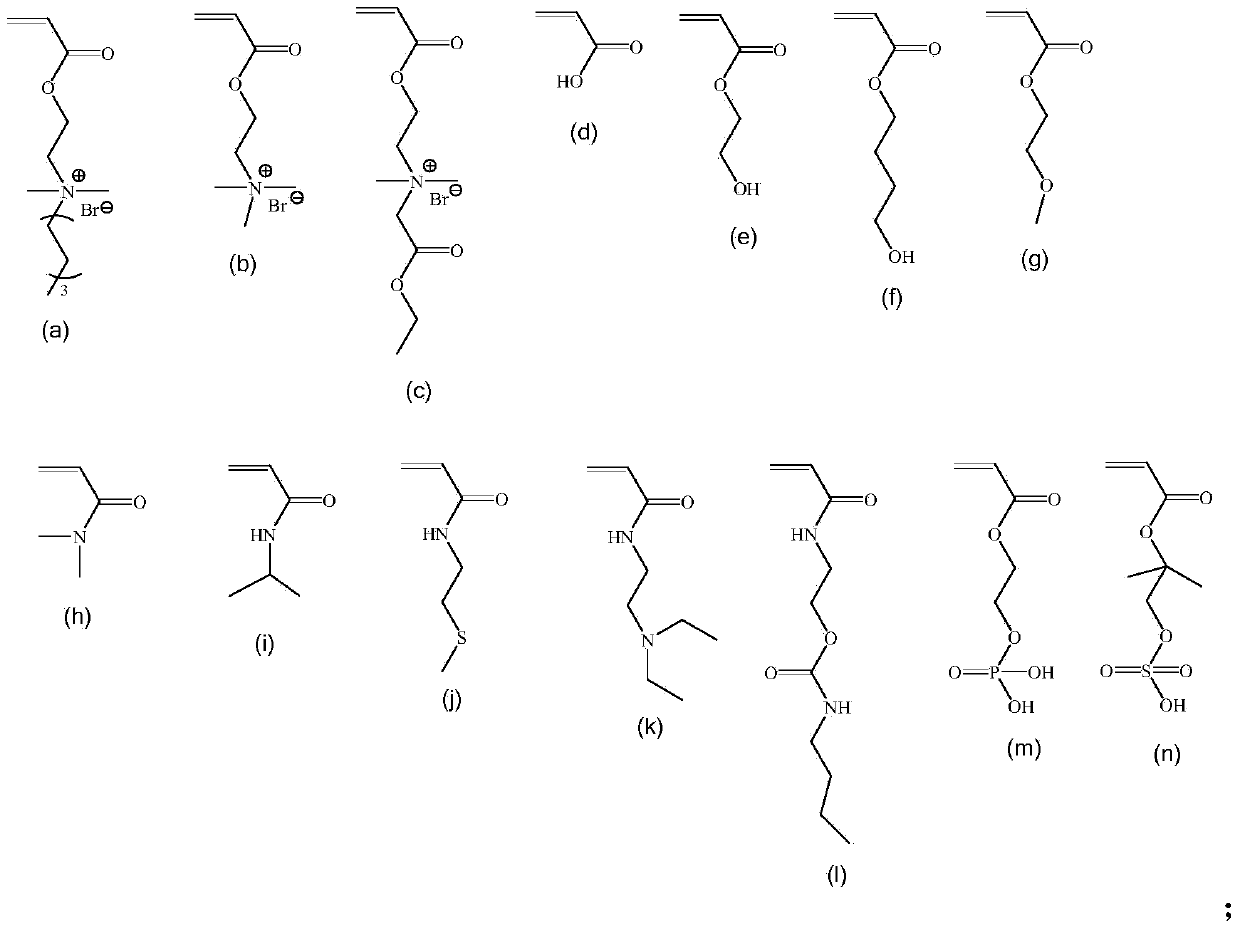Elastic gel support material for bone tissue engineering and preparation method of material
A technology of bone tissue engineering and elastic gel, applied in medical science, prosthesis, etc., can solve the problems of loss of mechanical properties, easy dissolution, poor cell adhesion, etc., and achieve excellent biological functions and mechanical properties
- Summary
- Abstract
- Description
- Claims
- Application Information
AI Technical Summary
Problems solved by technology
Method used
Image
Examples
Embodiment 1
[0048] Step (1). Add 1.09 g of gel N1 reactive monomer (c), 0.54 g of gel N1 reactive monomer (h), 0.024 g of N,N-methylenebisacrylamide cross-linked into a 15 ml plastic tube. The joint agent and tetramethylethylenediamine accelerator were dissolved in 6.5 ml of deionized water, and nitrogen gas was introduced for 30 minutes to remove the oxygen in the system. Shake well and react at 25°C for 12h to obtain gel N1.
[0049] Step (2). Take the gel N1 out of the plastic tube and cut it into a 1-3 cm columnar gel block with a knife. Prepare a 200 mL gel N2 reaction solution of acrylamide (28.4 g), α-ketoglutaric acid (0.58 g), and N,N-methylenebisacrylamide (0.062 g). Put the gel N1 gel block into the gel N2 reaction solution, seal it with aluminum foil, and shake it gently for 48 hours. Then, the fully soaked gel block was taken out and irradiated under an ultraviolet lamp at 25°C for 6 hours, and the double network gel was obtained by photo-initiated radical polymerization. ...
Embodiment 2
[0052] Step (1). Add 1.09 g of gel N1 reactive monomer (c), 0.54 g of gel N1 reactive monomer (h), 0.024 g of N,N-methylenebisacrylamide cross-linked into a 15 ml plastic tube. The joint agent and tetramethylethylenediamine accelerator were dissolved in 6.5 ml of deionized water, and nitrogen gas was introduced for 30 minutes to remove the oxygen in the system. Shake well and react at 25°C for 12h to obtain gel N1.
[0053] Step (2). Take the gel N1 out of the plastic tube and cut it into a 1-3 cm columnar gel block with a knife. Prepare a 200 mL gel N2 reaction solution of acrylamide (56.8 g), α-ketoglutaric acid (1.16 g), and N,N-methylenebisacrylamide (0.124 g). Put the gel N1 gel block into the gel N2 reaction solution, seal it with aluminum foil, and shake it gently for 48 hours. Then, the fully soaked gel block was taken out and irradiated under a UV lamp at 25°C for 8 hours, and the double network gel was obtained by photo-initiated radical polymerization.
Embodiment 3
[0055] The double network gel obtained in Example 2 was cut into small pieces of 5 mm * 5 mm * 2 mm, washed three times with deionized water, frozen at -20 ° C, and vacuum dried, and then soaked in 70% alcohol aqueous solution After 2 hours, wash with PBS three times in a sterile environment, and then soak in PBS overnight.
[0056] Adipose-derived mesenchymal stem cells were planted on double network gel, and DMEM growth medium containing 10% fetal bovine serum was added, and cultured for 3 days at 37°C under 5% carbon dioxide environment, and stained with DAPI dye. A large number of adipose stem cells adhered and grew on the surface of the gel, indicating that the gel has excellent biocompatibility. When the fullness increased to about 80%, the osteoinductive medium (StemPro, GIBCO) was used for culturing for 21 days at 37°C and 5% carbon dioxide. The double-network gel scaffold was stained with alizarin, and the calcification on the surface of the gel was observed under a ...
PUM
| Property | Measurement | Unit |
|---|---|---|
| elastic modulus | aaaaa | aaaaa |
Abstract
Description
Claims
Application Information
 Login to View More
Login to View More - Generate Ideas
- Intellectual Property
- Life Sciences
- Materials
- Tech Scout
- Unparalleled Data Quality
- Higher Quality Content
- 60% Fewer Hallucinations
Browse by: Latest US Patents, China's latest patents, Technical Efficacy Thesaurus, Application Domain, Technology Topic, Popular Technical Reports.
© 2025 PatSnap. All rights reserved.Legal|Privacy policy|Modern Slavery Act Transparency Statement|Sitemap|About US| Contact US: help@patsnap.com



